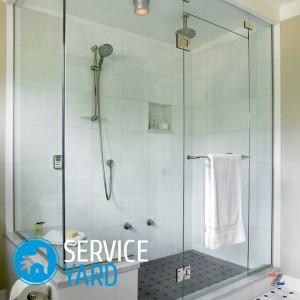DIY sliding bath screen

Often in the bathroom a person feels constrained. Many worry about droplets that fly around the room. As a result, swimming turns into discomfort rather than joy. But there is a thing that can fix this situation - it’s a do-it-yourself sliding bath screen. This interior detail is presented in a wide variety of options, but it does not require special knowledge to install it. It is easy to mount, so this work can be done independently.
to contents ↑Screen Benefits
Such a decorative fence has a number of advantages:
- Protection of the room against spray water;
- Transparent fabrication material does not add bulkiness to the room;
- Easy care;
- Aesthetic appearance.
Types of screens
There are differences in the structure of the screens. They may be:
- Wireframe;
- Frameless;
- Combined.
Frame screens
They are presented in the form of an aluminum frame with an ordinary glass or polycarbonate 4 mm thick inserted into it. The frame may include one or more frames.
Important! If water is sprayed strongly enough, it is better to pay attention to the frame screen, which includes several sections.
Here's how they can be arranged:
- Usually these are two fixed glass parts located at the edges and two movable parts - doors and a side wall. The moving parts are enclosed in aluminum frames, sliding on rollers along the profile.
- In the event that the location of the bathroom is a niche, then a screen consisting of two wings is installed. One of them is a fixed glass, the second a sliding door. An aluminum frame is also used to frame the flaps.
Frameless screens
Such a decorative element is made of thick tempered glass, the thickness of which is 6-8 mm. An aluminum frame is not used in this case. Thicker glass is intended for the production of fixed load-bearing parts of a screen, and thin glass is for moving parts. For fastening to the wall and the bathroom, an aluminum profile is used.
Combined screens
Such screens can be:
- Folding;
- Sliding
- Opening up.
Opening can be on hinges or hinges. Sliding screens have guides along which moving elements move.
to contents ↑Material for manufacturing
Before you make a screen for a bathroom with your own hands, you need to choose the material for it. Usually used:
- Polycarbonate is a versatile, durable material that perfectly copes with temperature extremes and exposure to moisture. Its main characteristic is high impact strength, so you can not be afraid of the appearance of cracks on the product after a strong impact. In addition, this material is very lightweight, easy to install and operate.
- Glass is an aesthetic material, the attractiveness of which does not disappear even after many years of operation. It does not form a fungus on it, the material is easy to clean with a simple tool for glass and a rubber brush.
Important! If the choice fell on a glass screen, it is worth paying attention to the triplex material - very durable, which does not crumble into fragments due to deformation.
- Plastic - a practical material, which attracts, first of all, low cost. Its main drawback is not as much strength and durability as other options.But, on the other hand, plastic is produced with a wide variety of colors and decor.
How to make a screen with your own hands?
In the event that the store does not have the product necessary for the size, you can make it yourself. In addition, a homemade option will cost much cheaper.
Important! If you plan to independently install the screen on the bath, it is better to choose plastic, since working with this material is easiest.
First of all, we will get the necessary materials and tools:
- Plastic;
- Profile;
- Pen;
- Self-tapping screws;
- With a simple pencil;
- A drill;
- Screwdriver;
- Construction knife;
- Sealant;
- Tape measure;
- Level.
Next, do the following:
- Take dimensions from the future screen.
- Using a construction knife, we cut out a panel of the required size from plastic.
- With the help of the level, we make markings for the plastic profile.
- On the walls we mark the places in which the profile will be attached.
- We make holes in the wall for fastening the profile.
- Using screws, we fix the profile on the wall.
- We fix the lower profile on the side of the bathroom.
Important! Fixing the lower profile is best done with sealant - this way the bath will not be damaged.
- Give the sealant a day to dry.
- We insert the plastic panel into the profile.
- From the opening side, the screen is limited by the same plastic profile onto which the handle is then mounted.
- Check the performance of the system.
Important! The same materials and the same principle are used to make a screen under the bathroom. It is used to mask ugly communications and household chemicals.
to contents ↑Important! In addition to plastic, tempered glass can also be used at home. But in this case, skills will require much more. The most difficult part in such a process is to drill holes for fastenings in glass, which can not always be done at home.
Stock footage
The process of making a screen for a bathroom cannot be called very complicated. When purchasing special rollers and appropriate mounts, it is possible to independently manufacture even a sliding or folding screen.







